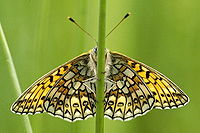- Boloria eunomia
-
Boloria eunomia 
Scientific classification Kingdom: Animalia Phylum: Arthropoda Class: Insecta Order: Lepidoptera Family: Nymphalidae Genus: Boloria Species: B. eunomia Binomial name Boloria eunomia
Esper, 1799Synonyms - Proclossiana eunomia
- Boloria (proclossiana) eunomia
The Bog Fritillary or Ocellate Bog Fritillary (Boloria eunomia) is a butterfly of the Nymphalidae family.
Contents
Description
The wings are orange-brown with dark markings. The color of the hindwings are orangish-brown with a tan postmedian band followed by a row of round silver spots. The length of the forewings is 20–24 mm. The butterfly may be threatened by bog hydrology.[1] The males search for females in wet areas.[2] The butterfly has the subspecies triclaris (from Newfoundland to Alberta), nichollae (Alberta), and denali (Alaska and northern Yukon). The butterfly flies close to the ground.[3] The species is listed as vulnerable.[4] They eat nectar from flowers including Labrador tea and goldenrod.[2] The species flies from the end of May till the beginning of August.[4] The butterfly can be identified form similar species by looking on the hindwing underside; this species is the only one with a row of silvery submarginal spots.[5]
Habitat
It is found throughout the north-temperate region of the Northern Hemisphere[5] including the Balkan Mountains of Bulgaria and one isolated population in Serbia.[6] The species is not mentioned in the Red Data Book of Serbian butterflies because it was not known to be in the country at the time of it being published.[6] The species is commonly found in open acid bogs in areas that are moist.[1] It can also be found in moist tundra and willow seeps.[2]
Caterpillars
The eggs are laid in groups of 2 to 4 under the host plant leaves.[2] When the eggs hatch in 7 to 8 days and after hatching, they feed on the underside of the leaves on the host plant. Caterpillars in Colorado and Wyoming are reddish-brown with red spines, with third or fourth instars hibernating. The caterpillars feed on Viola species and willows.[5] The caterpillars can be found from April to June.[7] The caterpillars are silver-gray with white dots.[3]
References
- ^ a b "Bog Fritillary (Boloria eunomia)". Wisconsin Department of Natural Resources. http://dnr.wi.gov/org/land/er/biodiversity/index.asp?mode=info&Grp=9&SpecCode=IILEPJ7020. Retrieved 2010-05-24.
- ^ a b c d "Bog Fritillary Boloria eunomia (Esper, 1800)". Butterflies and Moths of North America. http://www.butterfliesandmoths.org/species?l=1692. Retrieved 2010-05-24.
- ^ a b "Bog Fritillary Boloria eunomia (Esper, 1800)". Canadian Biodiversity Information Facility. http://www.cbif.gc.ca/spp_pages/butterflies/species/BogFritillary_e.php. Retrieved 2010-05-24.
- ^ a b "Boloria eunomia (Esper, 1799)". Catalogue of the Lepidoptera of Belgium. http://webh01.ua.ac.be/vve/Checklists/Lepidoptera/Nymphalidae/Beunomia.htm. Retrieved 2010-05-24.
- ^ a b c "Species Page - Boloria eunomia". Entomology Collection. http://www.entomology.ualberta.ca/searching_species_details.php?s=2829. Retrieved 2010-05-24.
- ^ a b "Boloria eunomia". Prime Butterfly Areas: A tool for nature conservation in Serbia. The Butterfly Conservation Europe and Serbian NGO HabiProt. http://www.habiprot.org.rs/23_eunomia.htm. Retrieved 2010-05-24.
- ^ Thomas J. Allen, James P. Brock, Jeffrey Glassberg (2005). Caterpillars in the field and garden: a field guide to the butterfly caterpillars of North America. Oxford University Press US. pp. 82. ISBN 978-0195149876. http://books.google.com/books?id=OWdD2bHSE-8C&pg=PA82&dq=Boloria+eunomia&hl=en&ei=iOX6S4zWHIL88AbHzLHvCg&sa=X&oi=book_result&ct=result&resnum=10&ved=0CE4Q6AEwCQ#v=onepage&q=Boloria%20eunomia&f=false.
External links
Categories:
Wikimedia Foundation. 2010.

